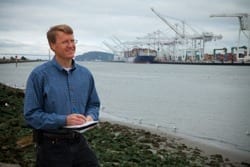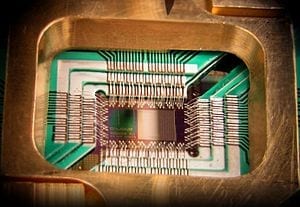
Providing auxiliary hydrogen power to docked or anchored ships may soon be added to the list of ways in which hydrogen fuel cells can provide efficient, emissions-free energy.
Hydrogen fuel cells are already powering mobile lighting systems, forklifts, emergency backup systems and light-duty trucks, among other applications. Now, researchers at Sandia National Laboratories have found that hydrogen fuel cells may be both technically feasible and commercially attractive as a clean, quiet and efficient power source for ships at berth, replacing on-board diesel generators.
The Sandia study was completed for the U.S. Department of Energy’s Office of Energy Efficiency and Renewable Energy (EERE).
Auxiliary power to docked ships, usually provided by on-board diesel engines, is a significant source of greenhouse gas emissions and air pollution, accounting for one-third to one-half of the in-port emissions attributed to ocean-going vessels. According to a 2004 study by the Natural Resources Defense Council, average daily emissions for a busy port could exceed the total emissions from nearly 500,000 vehicles.
Evaluating fuel cell barges at western U.S. ports
The study evaluated a simple fuel cell strategy that consists of mounting a hydrogen-fueled proton exchange membrane (PEM) fuel cell on a floating barge. Supplying a container ship with average power and run times (1.4 megawatts over 48 hours) requires four 40-ft containers, two for the fuel cell and two for hydrogen fuel storage, which could readily fit on a typical flat-top barge. For ships requiring less power, such as tugboats, a single container housing both the fuel cell and hydrogen will suffice, according to the Sandia study.
To evaluate the feasibility of the fuel cell barge strategy and analyze potential deployment options, Sandia’s Joe Pratt visited ports up and down the West Coast and in Hawaii. He gathered data from two U.S. Department of Transportation Maritime Administration facilities and the ports of Long Beach, Calif., Los Angeles, Calif., Oakland, Calif., Portland, Ore., Tacoma, Wash., Honolulu, Hawaii and Seattle, Wash.
“While Sandia has previously examined the potential for hydrogen and fuel cells in other applications, this is the first study of a maritime environment,” Pratt said.
Cheaper, cleaner than grid-based “cold-ironing”
A common alternative to auxiliary diesel engines is a practice called “cold-ironing,” in which a vessel at berth connects to a source of electricity on the shore. (The engine, made of steel or iron, literally becomes cold, hence the name.) Electricity supplied by a hydrogen fuel cell thus could become a new form of cold-ironing.
The U.S. Navy has been employing grid-based cold-ironing for many years to save fuel. Ports in California are now turning to the practice to meet the state’s environmental regulations. While only a few berths have grid-based cold-ironing, ports throughout California are installing infrastructure to meet the state Air Resources Board’s regulations that take effect in 2014.
But grid-based cold-ironing is complex and costly, and most ports lack the infrastructure needed to meet the power needs of multiple ships at berth. Those costs can run up to $5-10 million or more per berth, said Pratt. The Port of Oakland is installing 11 berths on six terminals at an estimated cost of about $70 million.
In addition, switching to grid-based power doesn’t eliminate emissions. Instead, that approach shifts the emissions to the source of electricity. Depending on the electricity source, the overall reduction in emissions can be relatively small.
Many potential deployment options, economic benefits
The hydrogen fuel cell barge bypasses the need for electrical infrastructure. The barge also has the capability of being moved from berth to berth as needed and to anchorage points to power vessels that are waiting for berths.
The Latest Bing News on:
Hydrogen fuel cells
- Toyota Execs Say Hydrogen Fuel Cells Are Ideal For A Tundra-Sized Pickupon May 7, 2024 at 3:36 pm
Having a hydrogen fuel cell power an electric pickup would allow it to match the range of combustion trucks. Toyota is one of a handful of automakers that believe hydrogen fuel cell electric vehicles ...
- Toyota and a Company Called Fuel Cell Energy Make Case for Hydrogenon May 7, 2024 at 2:43 pm
Toyota and Fuel Cell Energy have partnered to create a mini refinery to produce hydrogen for Class 8 fuel-cell trucks and electricity to run its port operations. The facility even produces clean water ...
- America’s first hydrogen garbage truck arrives in Las Vegason May 7, 2024 at 10:57 am
Hyzon just revealed North America's first hydrogen fuel cell-powered electric refuse truck at Waste Expo in Las Vegas.
- Ram hydrogen fuel-cell truck, BMW EV batteries, rural charging: Today’s Car Newson May 7, 2024 at 8:55 am
EV battery production for BMW is setting up south of the border. Ram aims to scale up its hydrogen fuel-cell muscle. And why do rural governments see EV charging as less important? This and more, here ...
- Fuel-cell Ram HD pickup included in Stellantis hydrogen rollouton May 7, 2024 at 8:52 am
Stellantis will produce a hydrogen fuel-cell Ram commercial truck, the head of the automaker's fuel-cell program said in a recent interview with German publication Welt am Sonntag (via Electrive).
- Welcome aboard the world's first hydrogen fuel cell superyachton May 7, 2024 at 8:12 am
That’s the idea behind the new Project 821, billed as the world’s first hydrogen fuel cell superyacht. Announced over the weekend by Danish shipyard cooperative Feadship, Project 821 arrives following ...
- Honda is looking to hydrogen fuel cells to solve the EV e-waste problemon May 7, 2024 at 6:57 am
E-waste is already an issue overwhelming global recycling, and EVs will soon be adding to it Hydrogen fuel cells have already been defining themselves as an im ...
- Press Release: Germany to further develop hydrogen fuel cell technologyon May 7, 2024 at 3:44 am
The further development of fuel cell systems for regional aircraft to the consortium during the project kick-off at Stuttgart Airport.
- Feadship Launches World’s First Hydrogen Fuel Cell-Powered Superyachton May 6, 2024 at 3:08 pm
This new, 390-foot-long superyacht (designed by RWD with owner’s representation by Edmiston), can provide carbon-emission-free power from green ...
- Low platinum fuel cells for hydrogen vehicleson May 6, 2024 at 3:31 am
New research from Sweden suggests that low platinum fuel cells for hydrogen vehicles, when scaled up for the same number of cells, may achieve similar or higher efficiencies compared to commercial ...
The Latest Google Headlines on:
Hydrogen fuel cells
[google_news title=”” keyword=”hydrogen fuel cells” num_posts=”10″ blurb_length=”0″ show_thumb=”left”]
The Latest Bing News on:
Hydrogen fuel cell barge
- Toyota and a Company Called Fuel Cell Energy Make a Case for Hydrogenon May 7, 2024 at 2:43 pm
Toyota and Fuel Cell Energy have partnered to create a mini refinery to produce hydrogen for Class 8 fuel-cell trucks and electricity to run its port operations. The facility even produces clean water ...
- New Way and Hyzon unveil first hydrogen fuel cell refuse truckon May 7, 2024 at 10:15 am
Class 8 fuel-cell powered electric refuse collection vehicle, North America’s first, is unveiled at WasteExpo.
- Maritime Partners, USCG Ink Design Basis Agreement for Innovative Hydrogen One Towboaton May 6, 2024 at 12:17 pm
The developer of an innovative towboat engineered to run on hydrogen generator technology has signed a Design Basis Agreement (DBA) with the U.S.
- Toyota advancing hydrogen fuel cells for cars, trucks, and even stationary poweron May 4, 2024 at 7:06 pm
Alternative power for cars typically means running on battery power, but Toyota's fanning out its alt-fuel development and sticking with hydrogen fuel cells as one option.
- HYDROGEN FUEL CELLon April 15, 2024 at 11:38 pm
As the focus on Hydrogen grows in India, Omega Seiki Mobility looks to introduce a Hydrogen fuel cell-powered 3-wheeler with a 400km driving range in a single charge. Around USD 5 million is ...
- hydrogen fuel cellon July 6, 2023 at 5:00 pm
According to [Charles Q. Choi], a new study indicates that grooves in the hydrogen fuel cells used to power vehicles can improve their performance by up to 50%. Fuel cells are like batteries ...
- Largest Ever Hydrogen Fuel Cell Plane Takes Flighton April 3, 2023 at 3:36 am
Universal Hydrogen hopes that hydrogen will do for aviation what batteries can’t. The company has been developing flight-ready fuel cells for this exact purpose, and has begun test flights towar ...
- Hydrogen Fuel-Cell Vehicles: Everything You Need to Knowon September 27, 2022 at 11:24 pm
That's the hydrogen fuel-cell vehicle, related to an EV but with specific differences that make hydrogen cars different and much rarer. To date, almost three million EVs have been sold in the U.S ...
- Clickable Fuel Cell Caron February 2, 2019 at 12:22 am
This is the heart of the hydrogen fuel cell car—the fuel cell stacks. Their maximum output is 86 kilowatts, or about 107 HP. Because hydrogen fuel cell stacks produce power without combustion ...
- Hydrogen peroxide could power future fuel cellon October 26, 2017 at 6:19 am
In the fuel cells, hydrogen peroxide serves two roles: it is a "catholyte," meaning it is both the electrolyte – a liquid that conducts electricity and allows the reaction to occur – and it is the ...
The Latest Google Headlines on:
Hydrogen fuel cell barge
[google_news title=”” keyword=”hydrogen fuel cell barge” num_posts=”10″ blurb_length=”0″ show_thumb=”left”]











